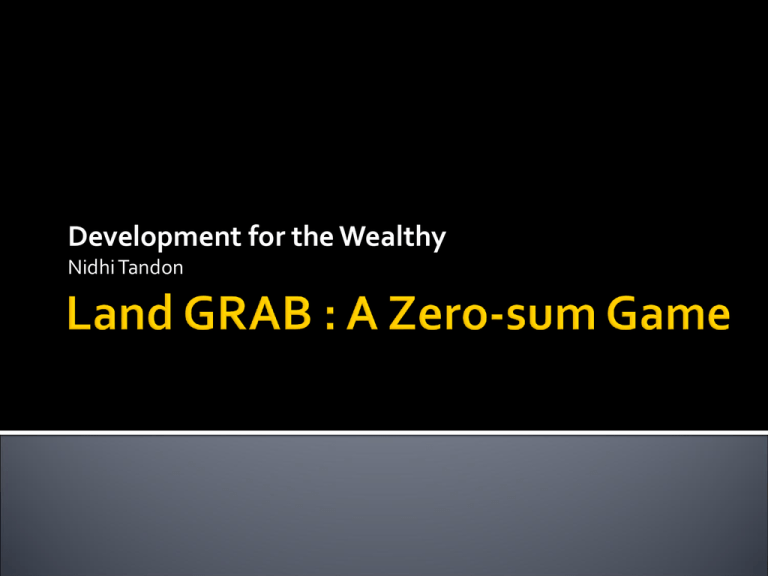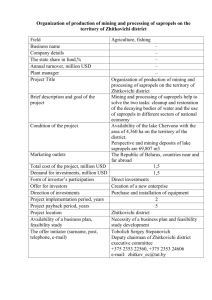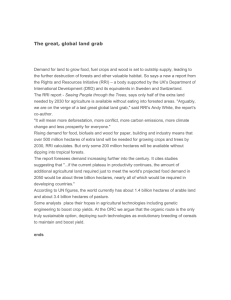Large Land acquisition phenomenon, drivers and
advertisement

Development for the Wealthy Nidhi Tandon What is now What is coming What could be Colonization, Decolonization, and Capitalism Anthony Hall Investors of all stripes and shades are rushing to stake their money on “the only source of genuine wealth and well-being for humanity” in the form of the finite properties of this small planet. A Bishop, a Chief and a land deal: converting the Church to an agro-fuel Inc. Macha, Zambia The Brethren in Christ Church (mission in Macha was founded in 1906 n the fertile farming district of Choma.. It claims 1215 hectares appropriated from the indigenous Tonga people in early 1900’s. The land was given to the church by the British South African company in 1920. Guinea USD45m., 100,362 hectares FARM LANDS OF GUINEA, INC. “unlocking the riches of an African Agricultural Treasure Trove” Backed by Govt. Ministry of Agriculture Soya beans and maize Ethiopia USD2.2m,. 2.9million ha Ethiopian EthiopianInvestment InvestmentAgency Agencyrecords show that 1,100 foreign records show that 1,100investors foreign have registered since 2005since , 72 foreign investors have registered investments haveinvestments requested over 2005 , 72 foreign have 5,000 ha. over 5,000 ha. requested Over Over2.9 2.9million millionha haof ofland landin intotal total was wasrequested requestedwith withaatotal totalplanned capital expenditure of 36.5 million planned capital expenditure of birr /36.5 US$million 2.2 million. birr / US$ 2.2 million. Mozambique USD 174m,. 7 million ha 2010 CEPAGRI report puts total area of land to be made available for large-scale agricultural activities at just under 7,000,000 hectares (19.4% of total arable land) of which 54% was considered suitable for large-scale agriculture and agro-fuel and the remaining 46% would be allocated for other purposes including forestry and grazing. Sector Area (hectares) USD Planned Projected Investment Employment Agro-fuels 89,012 19,464,516 9,542 Forestry 312,916 144,458,572 20,000 Food 31,856 10,318,719 3,012 433,784.98 174,241,807 32,554 Mozambique * - Emvest Limpopo * - EmVest Biofuels * - Deep Water Produce Swaziland * - EI Ranch South Africa Zimbabwe * - EmVest Nuts *- Ariston Holdings * - EmVest Evergreen * - EmVest Foods * - SA Farming Operations Zambia * - EmVest Livingstone “In South Africa and Sub Saharan Africa the cost of agriland, arable, good agriland that we're buying is 1/7th of the price of similar land in Argentina, Brazil and America. That alone is an arbitrage opportunity. We could be moronic and not grow anything and we think we will make money over the next decade.” Susan Payne, CEO, Emergent Asset Management Limited NATIONAL FRAMEWORKS Government’s Letter of Intent to the IMF Bilateral Investment Agreements (BITs) National Development Plans Poverty Reduction Strategy Papers (PRSPs) INTERNATIONAL FRAMEWORKS Multilateral Investment Guarantee Agency (MIGA) World Trade Organisation (WTO) Carbon Finance (CDM) International Chamber of Commerce (arbitration) Lome and Cotonou trade agreements EU Economic Partnership Agreements (EPA) “The economic growth potential of large scale investments is skewed due to an inadequate regulatory framework governing FDI in the sector ... The regulative framework does not provide the opportunity to protect and stimulate the domestic economy. No obligation to use inputs from the domestic economy combined with tax relief on imports of inputs can lead to an enclave industry with few links to the domestic economy. Mozambique has chosen to offer a mild tax regime, with significant reduction on the corporate tax. At the moment there are no restrictions on exports. This can lead to situations where goods that are in demand in the domestic economy are instead exported. There are also no restrictions on profit repatriation; therefore there is no guarantee that profits are reinvested in the domestic economy”. exemption of customs duties and VAT on capital goods as well as the respective spares and accessories reductions in profit tax (80% until 2015 and 50% from 2016 to 2025); numerous deductions on taxable income; profits repatriation authorized for a period of 25 years repatriation of the invested equity if foreign direct investment Authorization is not renewed; easy and cheap access to water including the Limpopo river (with no restrictions) and the HICEP main canal for which XXX has to pay not for the volume of water used but for the surface irrigated, at 250 Meticais/ha/year ($8.09/ ha/year.) Legal protection on property and rights, including industrial property rights; No restriction on borrowing and payment of interest abroad; Unrestricted transfer of dividends (payments to shareholders) abroad; Arbitration according to international rules for the resolutions of disputes on investments (such as those framed by the International Chamber of Commerce); Internationally endorsed services on issues related to investment risk insurance. Legality vs. Legitimacy ILO International Labour Standards International Standards on Agro-fuel production FAO Good Agricultural Practices (GAP) protocol Extractive Industries Transparency Initiative (EITI) Committee on World Food Security (CFS) land discussions in Rome in October 2010 submitted draft guidelines while calling for a moratorium on all large-scale land investments. Zambia Land Alliance – Civil Society Communiqué Community level arbitration of land disputes Pre-investment Environmental and Social assessments Land Grab x3 Foreign investment in land ventures capitalize at least three times: purchase or leasing of land at exceedingly competitive rates sale of a valuable in-demand commodity on the international market extraction of a large proportion of the profit directly to investors. Cheap labour, cheap land, infrastructure being developed “Uncrowded space” of opportunities, including gold, minerals, water, agriculture Important trading partner for the West Relatively insulated from global credit crisis as was never an integral part of credit cycle Land mass greater than USA, China and Europe combined China USA European Union (27) India Argentina Japan Total surface land 9,598,094 9,629,091 4,328,039 3,287,263 2,780,400 377,873 30,000,760 Africa (54) 30,312,382 Timberland investments have outperformed any other asset class regarding return and volatility over the past 60 years. They performed better than real estate, bonds or gold… which makes timber investments a perfect inflation hedge … trees will just continue to grow in volume and value exponentially. Klaus Biskup, Director of Sales & Marketing, EccoWood European CEO Journal April 2011 Sergey Gudoshnikov, economist at the British International Sugar Organization, sees the interest of many companies explained by the yields which are in southern Africa “considerably higher than Brazilian yields”, making it “one of the lowest-cost production regions in the world.” What is coming What are the implications of Zambezi River Basin: “A pre-investment document” USD 50 million/year crops& Agric USD 80 million/year fisheries USD 2.5 million/year medicinal and natural products Humphrey Elekani, Governance Director, ActionAid Zambia, Nov. 11th 2010 “Customary land has no ($) value; it cannot be bought or sold as it belongs to the people.” In other words, customary land is priceless, no economic value can accurately compensate for its common public value. He adds, “If we put a dollar value on customary land, we are headed for chaos”. P: The perceived value of land and nature is altered from how it can sustain life for generations to come to what it can ‘earn’ on the market today and in the short run. Q: When more and more of the planet’s land assets are valued using a $ metric on a global market, in other words, when nature is commoditized, what is at stake? R: An entire value system is at stake. P: We assume that land tenure security; equitable access to land; and the protection of natural resources; are central tenets to maintaining the assets of the silent majority in rural areas Q: Why is it, that in the face of the economic exploitation of land and labour in the land-grab context, we focus on the legalities of land rights as a solution for the rural poor? R: The legal system is a tool of the rich and powerful – it delivers verdicts, not justice P: Foisting individual land rights on the poorest or least powerful members of community does not automatically secure them power, wealth or income stability. Q: Why is it we assume ownership prevents landlessness? How do we protect the vulnerable? R: Community rights are being eroded The EU-25 has agreed on a binding target to reach a 20% share of renewable energy source in total energy consumption by 2020 (currently ~7%) 2/3 of the renewable energy is expected to come from biomass A Poyry/McKinsey study forecasts a 200 million m3/year wood deficit in Europe by 2020 If the target is enforced, we can expect upward pressure on global wood/biomass prices UK’s GHG Emission reduction targets among the most aggressive in EU SIX European countries (Italy, Norway, Germany, Denmark, the United Kingdom, and France) are among the largest investors in FDI stock in agriculture and in agri-fuel, their role cannot be ignored and deserves closer examination. FOOD CROPS African Palm Coconut Groundnut Maize Sweet Sorghum Sugarcane Sunflower Sesame Soya AGRO-FUEL AND OTHER Jatropha Wood Chips Biochar Oil & Grain crops Agrofuel crops Timber FUEL Replacing petroleum lifts the lid on the emerging global grab on plants, lands, ecosystems, and traditional cultures. The New Biomassters Synthetic Biology and the Next Assault on Biodiversity and Livelihoods is a critique of what OECD countries are calling 'the new bioeconomy.' Concerted attempts are already underway to shift industrial production feedstocks from fossil fuels to the 230 billion tones of 'biomass' (living stuff) that the Earth produces every year -not just for liquid fuels but also for production of power, chemicals, plastics and more. Exotic timber plantations, can use up to 2.5 times more water than native forests. Ecologists have discovered that timber plantations in Hawaii use more than twice the amount of water to grow as native forests use. The International Food Policy Research Institute (IFPRI) predicts that depending on rates of agro-fuel expansion, by 2020, the global price of corn will increase by 26% to 72% and the price of oilseeds between 18% and 44%. With every 1% rise in the cost of food, 16 million people are made food insecure. How will farmers be empowered to protect their food crops from being sold and used as fuel crops? … one power station operator in the UK estimated they would need 2.4 million tonnes of biomass (wood) per year which would require at least one million hectares of tree plantation to feed this one power station alone... What could be Land is a sovereign issue To sovereign or to unite Sovereignty is a people issue Indigenous People’s Movements International Treaty on Plant Genetic Resources Alternative farming frameworks (organic, IFOAM) Convention on Bio-Diversity People’s environmental movements around the world Use of all forms of media to support activism Making sure women have a voice In the land grab context, there is a difference between the ‘legality’ and the ‘legitimacy’ of the agreement, often they are legal in the strict sense of the word, but their legitimacy as far as rural people are concerned is highly questionable By engaging more people on a broader range of questions – such as How will rural women be empowered to understand the value of their land, to articulate their priorities and needs, and to claim these rights in a way that does not jeopardise the future of their families? How can rural women be supported in developing negotiation skills around the current and future value of farmland, water and natural resources? How can we ensure that women do not fall into a trap of the idea of land ownership in a context where even those (men) who have secure rights are not able to hold on to their tenure! WASHINGTON POST May 22 2011 World Rainforest Movement - Monthly Bulletin - Issue 166 - June 2011 “When the missionaries came to Africa they had the Bible and we had the land. They said 'Let us pray.' We closed our eyes. When we opened them we had the Bible and they had the land.” The simple truth about access to resources is that unless we are able to address the politics of access, dealing with structural issues of injustice, we are left with hollow quick fix solutions bereft of ethical or ideological values. In the pursuit of ‘efficiency at all costs”; we put women in a very vulnerable position because theses costs are simply too high for them to bear. “Plumpinut” vs healthy locallygrown foods Confidence about the future of our water and natural assets Being answerable to future generations! And just as this interest has grown, so has a counter movement to question the validity, viability and potential violations that unregulated and intense investment brings, led by farmer associations, civil society organisations and environmental groups. As national elites jockey to become shareholders in their own country’s natural wealth, the interests of the masses who cannot afford to become shareholders are simply swept away. Faced with this enormous tidal wave, it becomes an urgent imperative to work through as many avenues as possible to hold all shareholders, public and private alike, accountable to the socio-economic and environmental development impacts of their investments.






